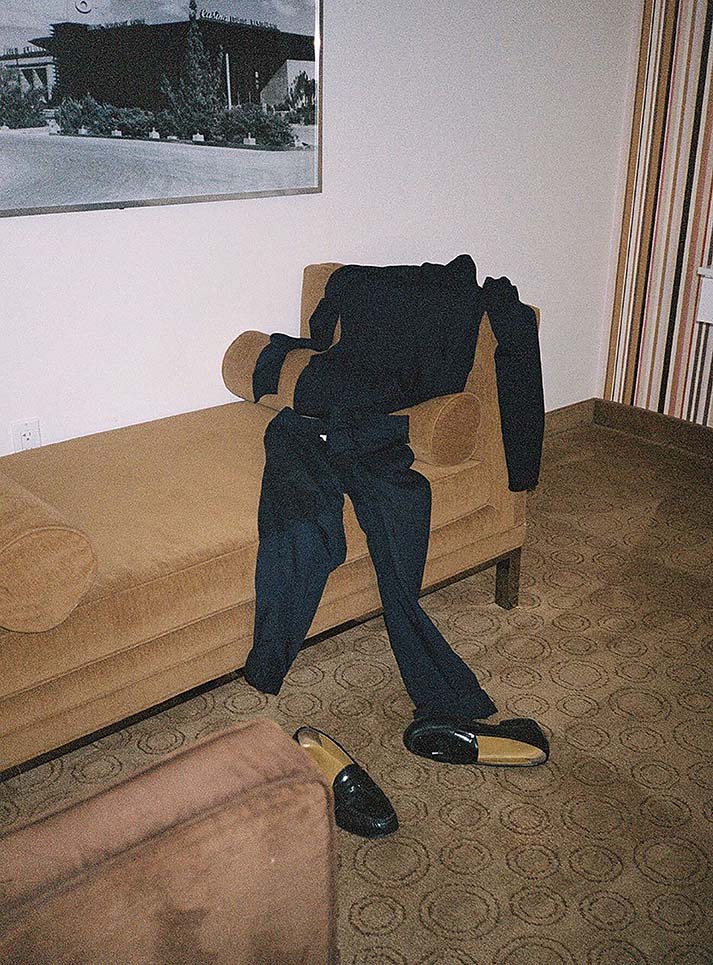
Cary Fagan Is on a Ladder to Infinity
Cary Fagan is scaling an artistic ladder that has placed him on the radars of Beyoncé, Kanye West, A$AP Rocky, Solange, and various other movers and shakers. Just like his part-deer, part-wolf persona, his climb to infinity is one that splits the fine line between real life and timeless magic. (ABOVE: Self-portrait, Las Vegas, available via timeless.goods.)
ASSORTED: Images of, or by, Cary Fagan.
SAMUEL HYLAND
In conversation, the multi-disciplinary artist Cary Fagan often embraces questions with silent self-interrogation, occasionally fetching his leather journal from a nearby table to jot down nuggets for an upcoming book. The first time this changes, a theme of being limited by one’s surroundings has been brought up. He sits with the question for a short while. After some time, with eyes that seem to scour for the right words in mid-air, he hesitantly concludes: “I’m a traveler. I like to travel, so . . . I never really struggled with that.”
But then, just as it seems like he’s finished speaking, he appears to cut himself off.
“I always take risks. I always do crazy things.”
I ask him to tell me the craziest thing he’s ever done.
“Have you ever missed a flight in a country you’ve never been to on purpose?” he poses in response.
Following an artist residency he participated in at a studio in Florence, Italy, this year, Fagan was kicked out of his temporary living space for an overstayed visit. All of the money he had was put toward a flight back home. On a phone call with him, his mother offered the unlikely advice of staying a bit longer.
“What do you do?” he asks rhetorically, now. “Do you come home, because you want to feel safe? Or do you just do it, because you’re already there? When something you want is right in front of you, sometimes you don’t immediately just pick it up – sometimes you don’t even get it. Those are those moments where you can either be something great, or you can go back to being comfortable.”
The example sits amongst many similar fledglings of a two-sided dynamic he began identifying with this year: deer and wolf. The wolf, he says, represents an aggressive side of him that takes center-stage when there is creative work to be pursued. Alternatively, the deer signifies a peaceful facet he discovered in a recent Japanese artist residency. Fagan’s initial attainment of the residency was the wolf’s doing: Driving home one afternoon, he received a text message from a friend encouraging him to apply to the program with her. He was accepted that very night – and within 24 hours, he had ordered a plane ticket to Japan and set out to learn the country’s native tongue. But upon arriving there, he found that there was an omnipresent sense of tranquility much less existent in the United States. In an Asia Society artist talk he was featured in last month, he recounted the moment his Jekyll and Hyde merged: “It was this circular piece of land; The deer was there, I was here, and we met in the middle. Then I fed it,” he said. “That exchange was nature giving me the power of showcasing vulnerability, and being able to use it in my creative process. Just being okay with having mistakes, and showing that; not having things be so perfect all the time. I always consider myself to have both energies. I was a wolf – but now I’m reborn a deer.”
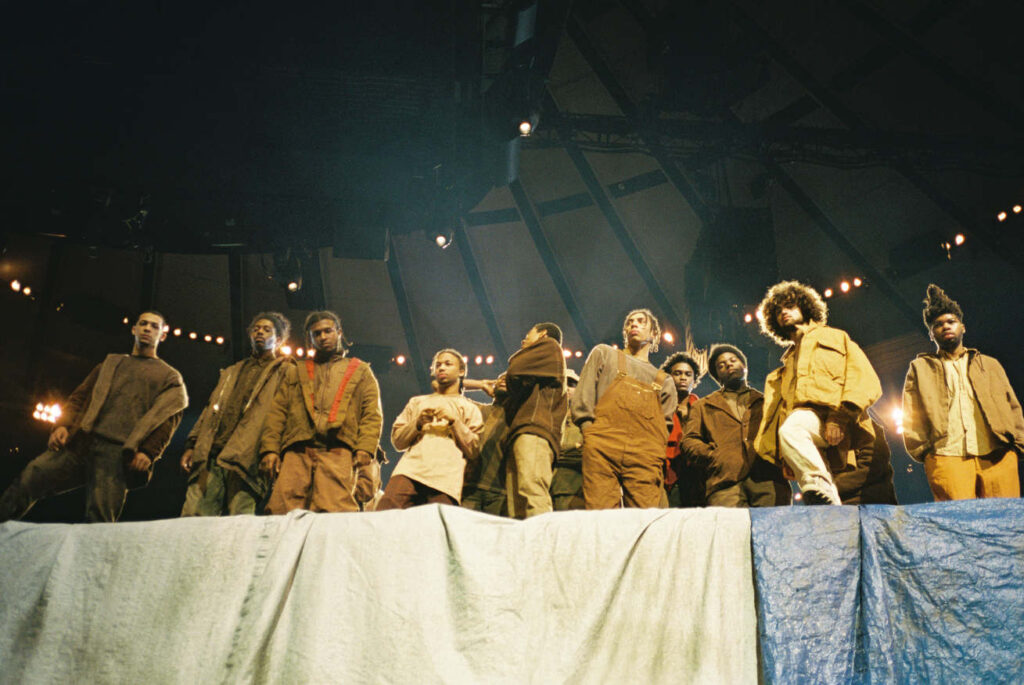
When I speak with him today over Zoom, he seems to be easing back into the deer side of his being. Having just returned to his Houston apartment from, first, a modeling shoot organized by a friend, and then a spontaneous post-shoot ramen outing held afterward, he’s found a cozy corner bearing three windows, with World of Warcraft handy nearby for once our interview is over. Fagan makes it a point that this is the busiest he’s been in quite some time. By this stage (6:30 CST) in the typical day, he’s already settled into a daily routine of journaling and video-game-playing, both of which are activities that help him to clear his head. And – more significantly – the typical day for Fagan starts at four o’clock in the morning and ends by noon. “At four or five AM, as soon as I wake up, I start jumping in place,” he tells me. “I start going crazy. I wake my body up. And then I do push-ups; it’s just routine. Then I’ll take a walk. After I take a walk, I get ready – it’s like I’m going to work: I take a shower, everything like I’m about to leave. And then I’ll come sit here, and I’ll read this book.” He holds up a copy of Ming-Dao Deng’s 365 Tao: Daily Meditations, the third book of similar Japanese adages he’s read since studying there in 2018. Today’s dictum, he says, was about learning. “Then I’ll write,” he continues. He grabs his journal from some place beyond the camera, then hoists it up, telling me that its contents will be published as a book in 2021. “And that’s the day. By then I’m answering emails- I’m just thinking of ways to operate, like What can I do to make the day better?”
From any external point of view, Fagan’s day-to-day lifestyle appears monotonous, deeply rooted in mindless repetitions. But it’s an opposite tactic of extracting adventure from tedium that’s fueled his growing legend in the world of high art up to now. The way he describes it, one is truly found when they’re lost, and lost when they’re found. To spend great amounts of time immersed in what you already know – being mentally “found” – you lose the creative wall of your soul activated by what is unexplored. In pushing yourself to venture into what you aren’t already familiar with, the concept of being “lost” triggers your spirit into assigning new meaning to its identity: something it doesn’t necessarily have to do whilst surrounded by everything it has ever known.
“It was no longer like ‘we hired you to be here.’ No – I’m here for a reason.”
The first time Fagan felt that he needed to find himself, he was living in his parents’ house at 25 years old. In years of cultivating a passion for photography ignited by exposure to his father’s work, he saw himself constantly feeling that there was something holding him back. Oftentimes, this barrier was his own mind. Yet, externally, mounting pressure from his parents to pursue a more conventional career path soon became Fagan’s primary burden. “I was fighting for approval,” he recalls. “Just to be accepted. I know I followed my dad when he was taking photos, but he was still also telling me Go to school. Get your degree. Finish school, get that job; photography is just for fun.” So eventually – in what he calls the most honest conversation he ever had with his father – he told him: “You didn’t prepare me for this. You’ve given me everything – I’m not prepared. I need to fight for something. You’ve given me too much.” For the first time, his father did not fight back. He left his parents’ house and moved in with a friend in Seymour, Texas, gaining income via small jobs while consistently working towards freelance photography. “I finally had this life of not having to go home, and have a curfew, and be told you shouldn’t do this,” he remembers, semi-smiling. “I was still checking in with my parents and stuff, I wasn’t just like I hate you guys, I don’t want to talk to you ever again. I was talking to them. But I also wanted them to take me serious.” Today, as his father has begun to pick up the camera again, the two have been more tight-knit than ever before – and more recently, Fagan’s mother reached out asking to work for him.
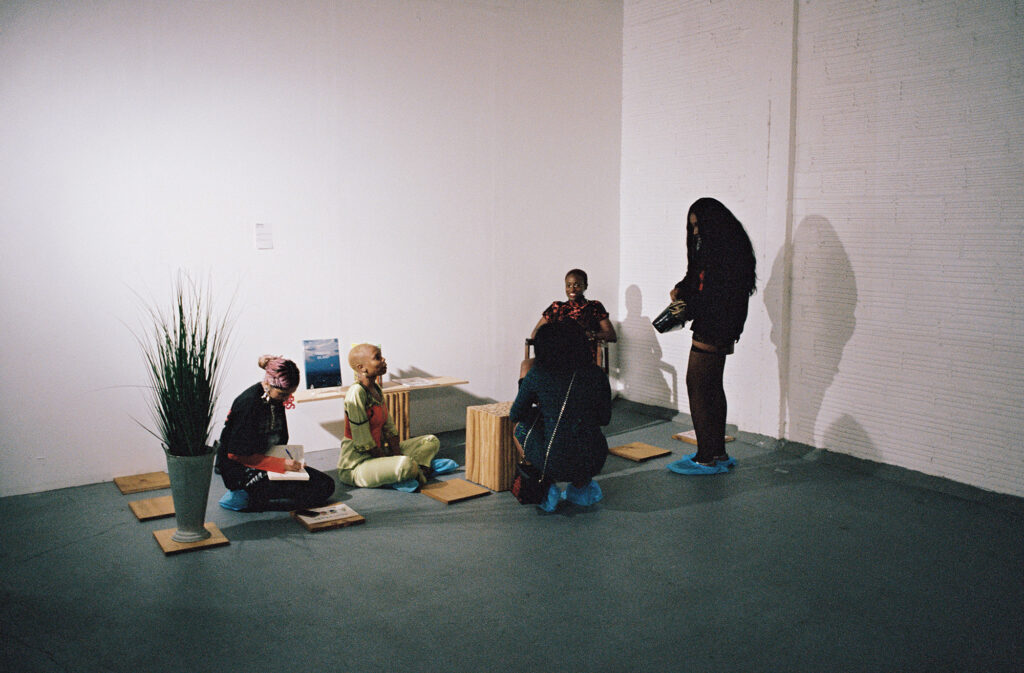
The respect of his parents, although a significant goal set by Fagan, is eclipsed by a more foundational mark he set for himself as a student at Brazos Bend Elementary School. “One day in elementary school,” he tells me, “I went to this table with a bunch of kids. And I just told all of them: One day I want to be famous. I want to do something. I want to be really special one day. That’s the only thing I said, and from that point on, I just believed that something was going to happen.”
Various somethings have commenced since Fagan left the house he grew up in. In 2016, he quit his job to fly out to New York for work with his first A-list client. Days later, he found himself sitting face to face with Kanye West. The Late Registration rapper expressed to him that he felt a reverence toward his work from what he heard – citing such appreciation as why he was hand-picking him to shoot his upcoming Yeezy Season 3 show and The Life of Pablo listening party in Madison Square Garden. “I felt my soul jump out of myself in the room,” he says of his initial meeting with West. “That was probably the time where, like, I really felt the pressure, the moment, the realization.”
Two years later, in 2018, he shot the musician Jazz Cartier for a Red Bull promo alongside Matthew Henson, a stylist he was connected with. Some time afterward, while he was playing World of Warcraft, he got a call from Henson: “I was just like Hey Matt, what’s up? You know, we were just checking up on each other, just friends talking. Then he’s like I have someone here who wants to talk to you; I’m going to put him on the line.” Still playing his video game, Fagan set his phone down to multi-task. “So I’m not looking at my phone, but then I recognize this voice. It’s like ‘Wassup G?’ My eyes look at my phone, and in my head I’m like Oh shit, that’s A$AP Rocky. But I’m playing my video game, and I’m in, like, a heated match, so I’m like Oh . . . what’s up?” During the phone call that ensued, Rocky expressed to him, in detail, what specifically about his work impressed him. Then, without specifying the project, he asked Fagan to work with him on a creative endeavor — and by the end of that calendar year, he had shot the cover of TESTING.
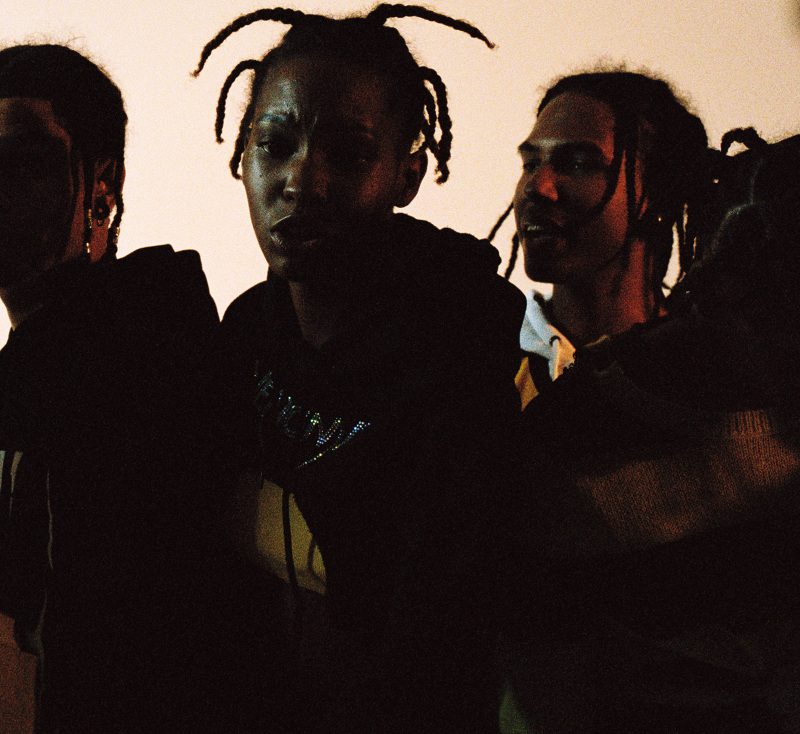
More recently, he found himself having a one-on-one over drinks. Sitting across the table from him was Solange Knowles. “It was very calm, and she outright told me that we have synergy,” Fagan recalls. The talk took place after he was recommended to Knowles for a performance art event in tandem with her single “Scales.” From that point, she began flying him out for collaborations more and more often, first landing him in Marfa, Texas, then Acrosanti, Arizona. A specific instance he recalls took place at some point within that very year: he was in Toronto to shoot film for a campaign, when he got a text from Knowles saying that he was needed in Berlin, Germany, by tomorrow. “Those types of decisions – just those movements – is what I love,” he says, asked about whether it triggered his complex of being lost and found at once. “It’s exhausting, but you’re hyper-aware. You’ve got to make decisions; you’ve got to work things out . . . you have to move.” His proudest moment as a member of Solange’s team was a product of such delegations. He smiles as he tells me: “People get to work with Solange, but the last time I worked with her, I got to sit at the table with her – her real team, like, the people she really trusts – and be a part of that, being able to use my voice to have input, and make team decisions.” The project being discussed at that point was Knowles’ critically acclaimed sixth studio album, When I Get Home. “That was a highlight for me, because I felt of importance in that room,” he continues. “I felt like I belonged there. It was no longer like we hired you to be here. No – I’m here for a reason.”
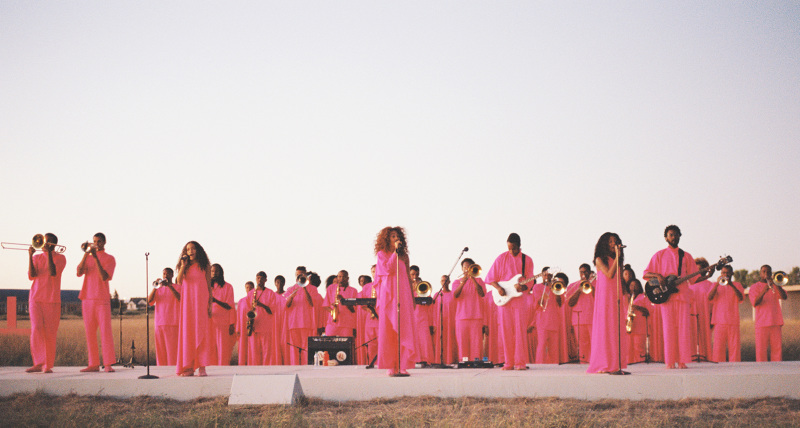
Cary Fagan sees himself permanently living in Japan someday. When I ask him about these plans, he does not hesitate to list several points he’s incorporated into his strict daily routine: on top of studying his book of meditations each morning, he’s been teaching himself Japanese diligently, with an added touch of having enrolled in a language class (he has a lesson scheduled for tomorrow). The point Fagan is intent on reaching is one that would allow him to interact at full capacity with locals. But, even without complete command of the speech element, connections he stumbled upon throughout his initial trip were profound enough to invigorate him about a possible return: One day, he reflected in his recent Asia Society artist talk, he was preparing to exit an onsen – a pool-like public bathing fixture popular in Japan – when he was approached by a young girl at a vending machine. Bearing ice cream, she asked Fagan to take a bite. Although initially confused, after some encouragement from the girl’s family, he obliged. There was no ulterior motive. They said good night to him, smiled and walked away. “That interaction was enough for me to be like I’m sold,” he recently said. “(Like) I want to be here.” Additionally, he recalls in our meeting, on one occasion, he was lent a bicycle by his host. While riding it, he was stopped by a police officer, who – thinking he stole it – asked where he got it from. When Fagan told him that it belonged to a friend, the officer did no further investigation: “He actually backed up, and he apologized to me. Because he knew that he was wrong.” The policeman told Fagan to have a good day, then bowed to him before going his separate way.
What the hell am I doing right now? How am I even living this life? Who am I? How is this possible right now?”
Yet, transcending the effects of all human interactions he saw over the course of his 2018 residency, the aspect of Japan that impacted Fagan most significantly was its ability to turn his focus inward. “Japan allows and provides space for you to think out loud and hear your thoughts,” he tells me, pausing between words to make sure he’s conveying exactly what he wants to convey. “Also, Japan allows you to hear the most beautiful silence, and just appreciate that moment.”
For Fagan, this silence is what directly inspired an ongoing project of his that’s gone global since its inception. He tells the story as if it happened yesterday: He was led into the studio by a host. Upon entering, the first things to catch his eye were ten wooden chairs assorted across the room. His first thought was to stack them.
“Within five minutes, I asked her can I just do this for my show?” he remembers. “She’s like Uh . . . I’ve never seen that done before, but . . . it should be fun.”
Chair stacking is a meticulous activity. On his first few attempts, mirroring internal struggles he faced through his career’s beginnings, he was hard on himself. “But then,” he realized, “when you accept that all things aren’t perfect, you can kind of move forward. So when the chairs fall, every time I’m doing this, I’m kind of getting numb to that tense feeling I would get when a loud noise happens, or something disrupts the state.”
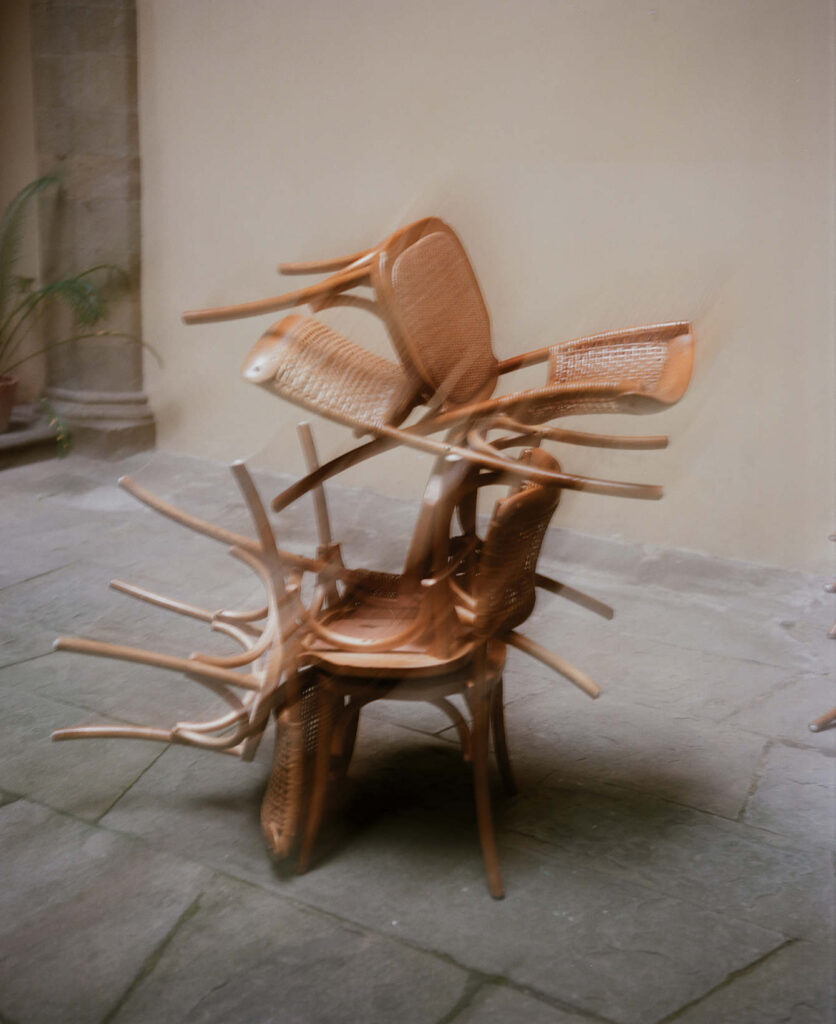
By the end of his residency, the chair stacking had become meditative. Peace gained in Japan went on full display when he performed the ritual before an audience this past November. Then, the setup was completely different. In place of solitude, there was a spotlight. In place of his studio, he was onstage. And in place of ten chairs, there were forty.
In the beginning, he emerged onto the screen, taking several steps into the exact center of a rug rolled out on the platform to bow. The room was dead silent, save for camera flashes and the occasional cell phone beep. Every time a chair shifted out of place, or crashed to the earth, one could hear audible exhales from the silent man stacking them. Nearly an hour passed before he descended from a ladder, marched towards the center of his creation – now a warped, jagged mass of human metal with limbs and extremities poking out from every face – and took one final bow before those spectating.
There is a distinct moment in the scene that replicates itself in various forms throughout Fagan’s career: standing atop the ladder, final chair in-hand, teary-eyed from the heart-stopping sensation of fulfilling a promise – even if that promise was to himself, and no one else.
“When I put the last chair up, I almost cried because I actually did what I said I was going to do,” he says to me. “And it took a long time for me to even get to that point, of just standing there. I came a long way; I was reflecting. I actually took the time to be still, before I finished it – I could have let myself cry, but it was enough time for me to be like: You did it. You can go ahead and finish this piece now. You can get off that ladder and bow to everyone.”
Cary Fagan is very in-touch with his tears. He often weeps when he wakes up. He wept when he finished the TESTING cover shoot. Already, he tells me, he feels tears welling up inside for an eight-page Dior spread that he’s been hired to curate, coming out early next week.
By the looks of it, there will be much more to weep for: his independent fine-art jigsaw puzzle company timeless.goods – enlisted by Beyoncé to assist the release of 2020’s Black is King – was just co-signed by ATTN and Constant Contact; the #chairsarepeople hashtag he started years ago in tandem with his chair stacking work has evolved into an international phenomenon; he’s in the process of launching a support system for young creatives via cf.filmstudios, a new project with groundwork still being laid.
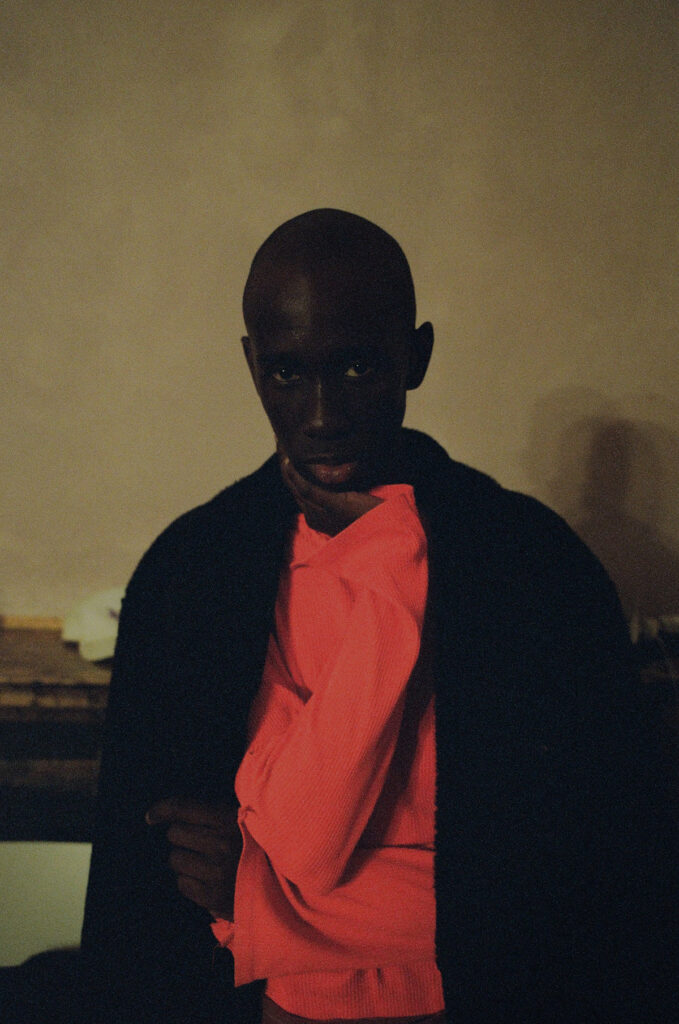
He says about the latter at one point: “It’s a window of opportunity for anyone who’s looking for answers, to equip themselves in an industry that doesn’t often give them the ones that they need. I have that experience. I have that voice.”
In our interview, that voice is a quiet one. It sits humbly in its delivery, seldom hasting to force itself, relinquished when necessary. But in the creative field it does its work in, it’s a booming tremor of authority and success. Though a deer in casual speech, it is a tenacious wolf when the line is crossed from informality to professionalism.
Asked about the tears he often cries upon waking up, the voice is quick to answer: “It’s just like What the hell am I doing right now? How am I even living this life? Who am I? How is this possible right now?”
Artistically, those answers are there: He’s merging deer and wolf. He’s earned his lifestyle by working for it. He’s a spearheading creative with talent sought after by the world’s leading voices.
What makes him different from most, though, is the fact that he still asks himself these things – and will continue to do so, no matter how much security is offered by heaps of external affirmation.
One night in March of 2019, working as a PA with SmartCar during that year’s SXSW Festival, Fagan found himself in a high-rise hotel room with A$AP Rocky, A$AP Ferg, Ian Connor, and Tisakorean. It’s a moment parallel to various other instances in which he’s been able to sit at tables alongside minds that shape arts and culture for generations, not as a spectator, but as an asset. For many others, top floors of such swanky high-rises represent summits on artistic mountains unclimbable, creative conference tables signifying statuses only seen on television and in books.
Much like when he placed the final chair upon his Asia Society sculpture, he now stands poised on a ladder. Much of what he said he would do, he has done. For as many tears that have already been cried, there are just as many welling up inside.
Does he ever look down to see how far he’s come?
“I feel like I’m climbing up a ladder to infinity,” he says as we close, World of Warcraft at the ready. “And that’s still how I feel. No, I don’t ever look down, because I still have a lot to learn. But in those moments, I own them – because I deserve them.”
